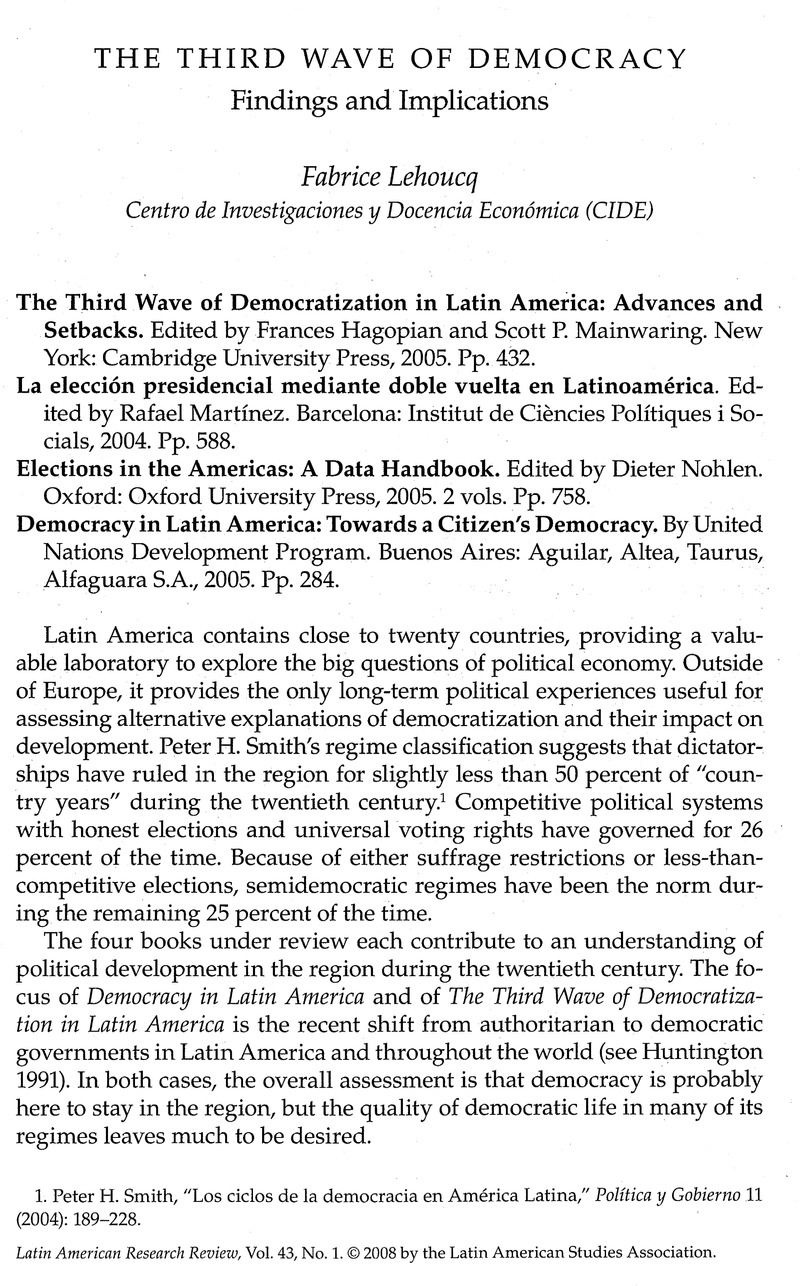Article contents
The Third Wave of Democracy: Findings and Implications
Review products
Published online by Cambridge University Press: 05 September 2022
Abstract

- Type
- Review Essays
- Information
- Copyright
- Copyright © 2008 by the University of Texas Press
References
1. Peter H. Smith, “Los ciclos de la democracia en América Latina,” Política y Gobierno 11 (2004): 189–228.
2. I make much the same argument about why incumbents reform electoral laws in a paper that Magaloni does not cite. See my article “Institutional Change and Political Conflict: Evaluating Alternative Explanations of Electoral Reform in Costa Rica,” Electoral Studies 14 (1995): 23–45.
3. See, e.g., Paul Collier and Anke Hoeffler, “Greed and Grievance during Civil Wars,” Oxford Economic Papers 54 (2004): 563–595; James D. Faeron and David D. Laitin, “Ethnicity, Insurgency, and Civil War,” American Political Science Review 97 (2003): 75–90; and Stathis N. Kalyvas, “The Ontology of ‘Political Violence’: Action and Identity in Civil Wars,” Perspectives on Politics 1 (2003): 475–494.
4. Jack A. Goldstone, et al., “A Global Forecasting Model of Political Instability,” paper presented at the Annual Meeting of the American Political Science Association, Washington, DC (September 1–4, 2005).
5. Kenneth A. Greene, “El votante mediano y la elección presidencial por mayoría relativa en México,” Política y Gobierno 14 (2007): 203–214. See also Cynthia M. McClintock, “Plurality versus Majority Runoff Rules for the Election of the President in Latin America: Insights from the 2006 Peruvian and Mexican Elections,” paper prepared for presentation at the meeting of the American Political Science Association, Philadelphia, PA (August 31-September 3). Mathew S⊘berg Shugart, “Mayoría relativa vs. segunda vuelta: La elección presidencial mexicana del 2006 en perspectiva comparada,” Política y Gobierno 14 (2007): 175–202.
6. Fabrice Lehoucq, “Costa Rica: Modifying Majoritarianism with a 40 Percent Threshold,” in Josep M. Colomer, ed., Handbook of Electoral System Choice (London: Palgrave Macmillan, 2007).
7. Gabriel L. Negretto, “Choosing How to Choose Presidents: Parties, Military Rulers, and Presidential Elections in Latin America,” Journal of Politics 68 (2006): 421–433.
8. Herbert F. Klein, Parties and Political Change in Bolivia, 1880–1962 (Cambridge: Cambridge University Press, 1969).
9. Fabrice Lehoucq and Iván Molina, Stuffing the Ballot Box: Fraud, Electoral Reform, and Democratization in Costa Rica (New York: Cambridge University Press, 2002), 41–43.
- 4
- Cited by




